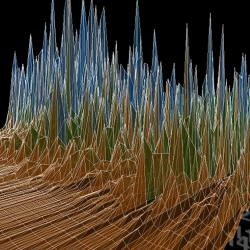
In Phase
The reason this works is that multiplying a sine wave by another sine wave is balanced modulation, which yields the sum and difference frequency sine waves. Any sine wave averaged over an integral number of cycles is zero.
Since the Fourier transform looks for components that are whole number multiples of the waveform section it is analyzing, and that section is also presumed to be a single cycle, the sum and difference results are always integral to the period.
The only case where the results of the modulation don’t average to zero is when the two sine waves are the same frequency. In that case the difference is 0 Hz, or DC (though DC stands for Direct Current, the term is often used to describe steady-state offsets in any kind of waveform).
Further, when the two waves are identical in phase, the DC value is a direct product of the multiplied sine waves. If the phases differ, the DC value is proportional to the cosine of the phase difference. That is, the value drops following the cosine curve, and is zero at pi/2 radians, where the cosine is zero.
So this sine measurement doesn’t work well if the probe phase is not the same as the target phase. At first it might seem that we need to probe at many phases and take the best match; this would result in the ESFT—the Extremely Slow Fourier Transform. However, if we take a second measurement, this time with a cosine wave as a probe, we get a similar result except that the cosine measurement results are exactly in phase where the sine measurement is at its worst. And when the target phase lies between the sine and cosine phase, both measurements get a partial match. Using the identity
for any theta, we can calculate the exact phase and amplitude of the target component from the sine and cosine probes. This is it! Instead of probing the target with all possible phases, we need only probe with two. This is the basis for the DFT.
Completing The Series
Besides probing with our single cycle sine (and cosine), the presumed fundamental of the target wave, we continue with the harmonic series (2x, 3x, 4x…) through half the sample rate. At that point, there are only two sample points per probe cycle, the Nyquist limit. We also probe with 0x, which is just the average of the target and gives us the DC offset.
We can deduce that having more points in the “record” (the group of samples making up our target wave cycle) allows us to start with a lower frequency fundamental and fit more harmonic probes into the transform. Doubling the number of target samples (higher time resolution) doubles the number of harmonic probes (higher frequency resolution).
Getting Complex
By tradition, the sine and cosine probe results are represented by a single complex number, where the cosine component is the real part and the sine component the imaginary part.
There are two good reasons to do it this way: The relationship of cosine and sine follows the same mathematical rules as do complex numbers (for instance, you add two complex numbers by summing their real and complex parts separately, as you would with sine and cosine components), and it allows us to write simpler equations. So, we refer to the resulting average of the cosine probe as the real part (Re), and the sine component as the imaginary part (Im), where a complex number is represented as Re + i*Im.
To find the magnitude (which we have called “amplitude” until now—magnitude is the same as amplitude when we are only interested in a positive value—the absolute value):
In the way we’ve presented the math here, this is the magnitude of the average, so again we’d have to multiply that value by two to get the peak amplitude of the component we’re testing for.
Many computer languages and math packages support the atan2 function. Basically, this gives the arc tangent of Im/Re, while handling the special cases of the four quadrants and divide by zero for you. This give you the phase shift of each harmonic in radians. Since the real part corresponds to cosine, you can see that a harmonic with an imaginary part of zero results in a phase of zero—corresponding to a cosine.


